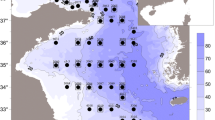Abstract
Systematic sampling of communities gives rise to large contingency tables summing up possible changes in the assemblages' structure. Such tables are generally analysed by multivariate statistical methods, which are ill-suited for simultaneously analysing rare and common species (Field et al., 1982). In order to separately process species belonging to either of these categories, we propose a statistical method to select common species in a sequence of ecological surveys. It is based on a precise definition of rarity, and depends on a rarity parameter. In this work, this parameter will be optimised so that the sub-table of common species captures the essential features of the complete table as well as possible.
In this way we analysed the spatio-temporal evolution of macrobenthic communities from the Algiers harbour to study the pollution influence during a year. The examination of the communities' structuring was done through Principal Components Analysis (PCA) of the species proportions table. Environmental variables were simultaneously sampled. We show that the data structure can be explained by about 25% of the total number of present species. Two environmental gradients were brought to the fore inside the harbour, the first one representing pollution, and the second one representing hydrological instabilities.
Since rare species can also convey information, the complete table was also coded according to a generalised presence/absence index and submitted to Correspondence Analysis. The results were consistent with those of PCA, but they depended on more species, and highlighted the influence of sedimentology on the assemblages composition.
Similar content being viewed by others
REFERENCES
Critchley, F. (1988). Principal components analysis: some majorisation, perturbation and nonnegative matrix theory. Statistique et Analyse des Données 13: 8–14.
Field, J.G., K.R. Clarke and R.M. Warwick (1982). A practical strategy for analysing multispecies distribution patterns. Marine Ecology Progress Series 8: 37–52.
Fromentin, J.M., J.C.Dauvin, F. Ibanez, J.M. Dewarumez and B. Elkaim (1997). Long-term variations of four macrobenthic community structures. Oceanologica Acta 20: 43–53.
Gaston, K. J. (1994). Rarity. Population and Community Biology Series 13, Chapman and Hall, London.
Gaston, K. J. (1997). What is rarity? In: Kunin, W.E. and K.J. Gaston (Eds). The biology of rarity. Causes and consequences of rare-common differences. Chapman and Hall, London. pp. 30–47.
Golub, G.H. and F.V.L. van Loan (1996). Matrix computation (third edition). The John Hopkins University Press, Baltimore and London.
Ibanez, F. (1991). Treatment of the data deriving from the COST∖647 project on coastal benthic ecology: the within-site analysis. In: Keegan, B.F. (Ed.). Space and Time Series Data Analysis in Coastal Benthic Ecology. An analytical exercise organized within the framework of the COST 647, Project of Coastal Benthic Ecology, Commission of the European Communities. pp. 5–41.
Ibanez, F. and J.C. Dauvin (1988). Long-term changes (1977 to 1987) in a muddy fine sand Abra alba-Melinna palmata community from the Western English Channel: multivariate time-series analysis. Marine Ecology Progress Series 49: 65–81.
Kenkel, N.C. and L. Orloci (1986). Applying metric and nonmetric Multidimensional Scaling to ecological studies: some new results. Ecology 67: 919–928.
Krzanowski, W.J. (1987). Selection of variables to preserve Multivariate Data Structure, using Principal Components. Applied Statistics 36: 22–33.
Manté, C. and J.P. Durbec (1995). Sélection d'espèces dominantes et présences-absences lissées. Une application à l'analyse exploratoire de données écologiques. In: Actes des XXVIImes Journées de Statistique: 436–442.
Manté, C., J.C. Dauvin and J.P. Durbec (1995). Statistical method for selecting representative species in multivariate analysis of long-term changes of marine communities. Applications to a macrobenthic community from the Bay of Morlaix. Marine Ecology Progress Series 120: 243–250.
Manté, C., J.C. Dauvin and B. Elkaim (2001). Methods for selecting dominant species in ecological series. Application to marine macrobenthic communities from the English Channel. Journal de Recherche Océanographique 26: 29–36.
Manté, C., J.P. Durbec and J.C. Dauvin (1997). Analyse de l'évolution temporelle de communautés macrobenthiques à partir des probabilités de présence des espèces. Oceanologica Acta 20: 71–79.
Peres, J.M. and J. Picard (1964). Nouveau manuel de bionomie benthique de la Mer Méditerranée. Recueil des travaux de la Station Marine d'Endoume 47: 3–137.
Preston, F.W. (1948). The commonnness, and rarity, of species. Ecology 29: 254–283.
Rebzani-Zahaf, C. (1990). Les peuplements macrobenthiques du port d'Alger. Evolution spatiotemporelle. Impact de la pollution. Thèse de Magistère. ISN/USTHB, Alger.
Rebzani-Zahaf, C., G. Bellan, A. Bakalem and J.C. Romano (1997). Cycle annuel du peuplement macrobenthique du port d'Alger. Oceanologica Acta 20: 461–477.
Sanders, H.L. (1960). Benthic studies in Buzzard Bay III. The structure of the soft-bottom community. Limnology and Oceanography 5: 139–153.
Souprayen, J., J.C. Dauvin, F. Ibanez, E. Lopez-Jamar, B. O'connor and T.H. Pearson (1991). Long-term trends of macrobenthic communities: numerical analysis of four north-western european sites. In: Keegan, B.F. (Ed.). Space and Time Series Data Analysis in Coastal Benthic Ecology. An analytical exercise organized within the framework of the COST 647, Project of Coastal Benthic Ecology. Commission of the European Communities: 265–438.
Stephenson, W. and S.D. Cook (1980). Elimination of species before cluster analysis. Australian Journal of Ecology 5: 263–273.
Author information
Authors and Affiliations
Rights and permissions
About this article
Cite this article
Manté, C., Claudet, J. & Rebzani-Zahaf, C. Fairly Processing Rare and Common Species in Multivariate Analysis of Ecological Series. Application to Macrobenthic Communities from Algiers Harbour. Acta Biotheor 51, 277–294 (2003). https://doi.org/10.1023/B:ACBI.0000003984.95892.bb
Issue Date:
DOI: https://doi.org/10.1023/B:ACBI.0000003984.95892.bb




